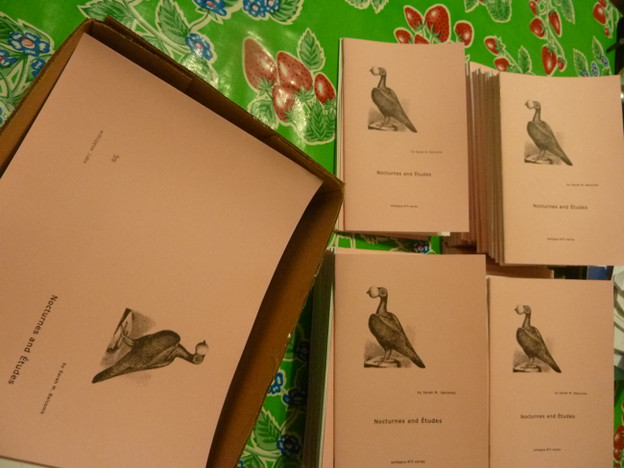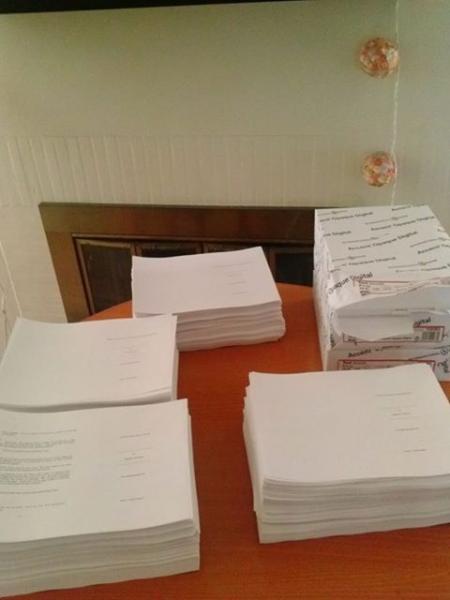eohippus labs: Who we are, how we started, and where we think we might be going
by Amanda Ackerman

Do not wonder how you will do a job, but do it and then wonder how you have done it
I am always thinking about time. In many ways, we live in terrible times. Also, it is said that if you travel far enough into the future you will actually go back in time.
eohippus labs is a short-form literary micropress based in Los Angeles. I co-edit the press with Harold Abramowitz, who is also someone with whom I write collaboratively, and he is also one of my best friends. We are one publisher in the world among many other publishers. We want to get writing that we like into the world so it can exist and circulate in a materially-concrete published form.
It is hard to find time to run a press.
The squirrel consider himself owner of the land and yet fears the farmer [sic]
I will begin again by telling you about the once-living creature Eohippus. All of this information I have gleaned or foraged (gleaned if you think the internet has already been picked-through; foraged if you think the internet is producing fruit) so you can decide whether it’s reliable, unreliable, or usefully fictive. The eohippus is an extinct prehistoric animal that is known as the “dawn horse.” It lived in the early Eocene era, about 50 million years ago. It probably looked like a miniature, spotted, cloven horse and was bigger than a fox. It was probably the size of a small dog, with a small thin tail. It lived in swamp-like forests, hid from predators in the shadows, and lived off the leaves of bushes and short trees. As time went by, eohippus changed. But for 20 million years, it didn’t change that much, evolutionarily speaking. Flash forward in time to a moment slightly before ours. There now exist paleobiologists. For many decades, they considered Eohippus to be the linear ancestor of Equus, the modern day horse.

For many decades, scientists considered Eohippus the ancestor of the modern-day horse.
Then new science replaces old science, and this idea changes. New science explains that the evolution of the horse is non-linear, like a many-branched tree. Equus happens to be the only branch of the horse now in existence. Eohippus is still considered an ancestor of Equus, but in a less linear way. For some reason, scientists seem to know more about the evolutionary lineage of the horse than any other animal.

Extinct equids. True to scale.
Also, there is now the idea that Equus is not the goal, or the crowning jewel, of a naturally-selected lineage.
As part of this many-branched tree, the indigenous horse died out in North America about 12,000 years ago. The Spanish brought domestic horses to the New world at the end of the 1400s. Therefore, if you encounter wild horses in the United States, they are feral.
Harold and I named the press eohippus labs. I’m sure there are many metaphors in this namesake for running a press (like the idea of textual transplantation and consciously taking part in the adaptation of language, or how publishing is writing). However, the eohippus is an extinct creature, not a metaphor.
An inefficient workman quarrels with his tools
The press started for a number of reasons. Harold and I were second-year students in the MFA writing program at CalArts. We were taking Matias Viegner’s experimental writing class, and Matias asked us to compose a theory of language.
I wrote a piece about how humans did not create language and how language is not a tool to be used by us. I was tired of hearing about the deficiencies and inadequacies and tyrannies and (un)deadness of language, as if somehow those were the faults of language, and not the faults of our own inadequacies and tyrannies and (un)deadness. I ignored all concern for logical fallacies, and claimed language to be sentient, living symbols (although language and humanity certainly share a contingent and co-evolutionary relationship). I said we need to talk with language and that writing can be a process of fanatical listening, human-language concurrence, and co-making. I called this piece “Theory of Language,” and Harold liked it. For his assignment, Harold wrote a piece about the eohippus. His piece had many permutations and repetitions, and it made language turn into aggregates of atmosphere. Sometimes humanity generated this atmosphere, sometimes we navigated it, and sometimes (as with state-tyranny) it was forcefully imposed on us. Sometimes, this atmosphere (as with state-tyranny) was trying to kill us or make us mechanistic or make us (un)dead, and sometimes this atmosphere encouraged us to thrive. Language felt time-specific, archaic, futuristic, and time-shattering all at once. In any case, I liked this piece of writing a lot. Harold also had a book of Nigerian pamphlets that we both liked called Life Turns Man Up and Down. These pamphlets were short, quickly produced, quickly circulated, and sold in an open-air market. They are described as “brief literary anomalies in all genres, written for entertainment, instruction, and moral guidance.” Harold and I began to talk about resuscitating the form of the pamphlet (although we have since given up on the idea of “quick” production and circulation – it’s hard to find time to run a press).
Lastly, Harold decided he wanted to start by publishing “Theory of Language” as a pamphlet, which he did, and he did all the work (layout, printing, stapling, folding, boxing up) solo. And then I joined him for all eohippus labs projects since.

The pygmy seahorse, one of my favorite creatures in existence. It is currently threatened because the coral beds where it lives are dying, and the coral beds might be dying because the Pacific Ocean itself might be dying. The Pacific Ocean might be dying due to causes of global warming, radiation from Fukushima, over-fishing, shark-finning, oil spills, among others. We live in puzzling times.
If idiots don’t go to the market, bad wares will not be sold
We say on our website that eohippus labs is interested in the “uncategorizable text.” However, were I to revise that idea, I’d say we are interested in the less recognizable text, or the text whose use of language and idea is less recognizable within more recognizable forms (like the pamphlet, the anthology, or the short story).
Right now, eohippus labs is subdivided into four series: eohippus tract (a pamphlet series), emohippus (small anthologies of emotional writing in the form of greeting cards – because conceptual writing is emotional), eohippus n°5 (innovative narrative, because we’d like to see more interesting prose being published, and because we don’t draw a huge distinction between poetry and prose), and stealth (which involves the covert circulation of texts with endlessly repetitive structures).
Everything we make comes from Harold’s living room.

Harold’s living room with recently printed material from a Samsung MLT-D20FL printer. We need to honor our machines.
Instead of people sending us work that they have already written (although that does happen), we often like to create projects that will generate work from scratch. For example, emohippus came into existence because we contacted various writers and asked them to send us emotional writing. We also know a lot of people who are good at smart, impromptu rants (you are sitting at a table, and suddenly your friend slips into a tirade about why people in Los Feliz need to stop having babies, or why the mythological creature the Thunderbird needs to be more widely respected and recognized), and we ask them to transfer their vocalizations into tighter forms of printed writing. (We have since learned, however, that many writers find this form of transference very hard to do).
So far, this is what we have published in the eohippus tract series:
Stan Apps writes about how poetic language is different from normal language;
Michelle Detorie writes about how she wishes everything would keep on living and never die;
Will Alexander writes planetarily, and for the future, to move us beyond a history in which our psyches come into being through conflict;
Cara Benson writes about how she wrote a political poem on how dairy cows suffer and why that poem was not considered a good poem;
Janice Lee writes about how the existence of other worlds affects our writing and vice-versa;
Opal McCarthy writes about what goes in and out of girls’ mouths and how we can write in an era of nuclear seepage;
Christopher Russell writes about the mystical accident and how some photographs have literally brought living creatures into existence.
For emohippus:
Teresa Carmody apologizes to you and makes herself sick; Dan Richert summons courage; Matthew Timmons shows mercy; Vanessa Place lets us share the commonality of death; Allison Carter loves, wants love and doesn’t want love; Carribean Fragoza takes us into the disorientations and reorientations of grief; Teresa Carmody apologizes to you and becomes a martyr; Joseph Mosconi curses, exclaims, interjects; SAM OR SAMANTHA YAMS shows us why Tyra Banks is a hero; Amina Cain wonders whether or not we can be told we’re okay; Teresa Carmody congratulates you on having a new baby, or giving birth to a new version of yourself, and cheers second chances; Honey Crawford intensifies the feelings you feel when someone unlooses mayhem on you; Daren Klein let’s us know that when someone writes to “you,” you will never be forgotten; Dolores Dorantes takes us into the margins of poesis; SAM OR SAMANTHA YAMS writes about the language of brothers and sisters in concert; K. Lorraine Graham discusses what happens when intuition is off; Amaranth Borsuk is dolorous, is pain itself; Teresa Carmody sympathizes with you; Mark Lamoureux spins us at different intervals than the spinning world; j.s. davis tells you what to do and tells you you’re telling her what to do; SAM OR SAMATHA YAMS shows us that our saviors are not pessimists.
eohippus n°5 so far:
Allison Carter’s story. The setting is a house, and maybe time itself.
Eireene Nealand’s story. The setting is a court of law.
Sarah M. Balcomb’s story. The setting is New York City.
stealth:
“Man in the world of money…The Turning Point.”
Proverbs are the palm oil with which words are eaten
Here. I’ve written you a book. I’ve started something, and as a result, have asked for your time. Reader, you are a temporal part of my imagination. And I will write you another book, and it will be a lovely read.
A Primer